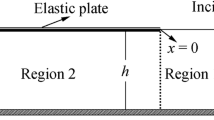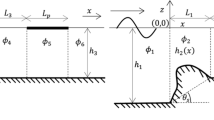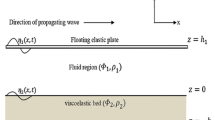Abstract
In the present study, the interaction of surface gravity waves with a very large rectangular floating flexible plate is analyzed in shallow water depth. The horizontal dimensions of the floating structure are much larger than the wavelength of the incident wave. The associated boundary value problem (BVP) is solved by considering the draft of the plate is negligible, and the bottom surface of the plate is floating on the still water level (SWL). The solution technique is based on the parabolic approximation in which the solutions in the open water regions are matched appropriately with the solution in the plate covered region. The effect of the compressive force on the plate deflection is analyzed in a detailed manner. Further, the occurrences of the blocking phenomena above the critical value of the compressive force are illustrated.








Similar content being viewed by others
References
Wang, C.M., Tay, Z.Y., Takagi, K., Utsunomiya, T.: Literature review of methods for mitigating hydroelastic response of VLFS under wave action. Appl. Mech. Rev. 63(3), (2010)
Ohkusu, M., Namba, Y.: Hydroelastic analysis of a large floating structure. J. Fluids Struct. 19(4), 543–555 (2004)
Wang, C.M., Tay, Z.Y.: Very large floating structures: applications, research and development. Procedia Eng. 14, 62–72 (2011)
Lamas-Pardo, M., Iglesias, G., Carral, L.: A review of very large floating structures (VLFS) for coastal and offshore uses. Ocean Eng. 109, 677–690 (2015)
Sahoo, T.: Mathematical Techniques for Wave Interaction with Flexible Structures. CRC Press, Boca Raton (2012)
Kashiwagi, M.: A B-spline Galerkin scheme for calculating the hydroelastic response of a very large floating structure in waves. J. Mar. Sci. Technol. 3(1), 37–49 (1998)
Stoker, J.J.: Water Waves: The Mathematical Theory with Applications, vol. 36. Wiley, Hoboken (2011)
Greenhill, A.G.: Wave motion in hydrodynamics. Am. J. Math., 62–96 (1886)
Kerr, A.D.: The critical velocities of a load moving on a floating ice plate that is subjected to in-plane forces. Cold Reg. Sci. Technol. 6(3), 267–274 (1983)
Bennetts, L.G., Williams, T.D.: Water wave transmission by an array of floating discs. Proc. R. Soc. A Math. Phys. Eng. Sci. 471(2173), 20140698 (2015)
Meylan, M.H., Bennetts, L.G., Mosig, J.E.M., Rogers, W.E., Doble, M.J., Peter, M.A.: Dispersion relations, power laws, and energy loss for waves in the marginal ice zone. J. Geophys. Res. Oceans 123(5), 3322–3335 (2018)
Watanabe, E., Utsunomiya, T., Wang, C.M.: Hydroelastic analysis of pontoon-type VLFS: a literature survey. Eng. Struct. 26(2), 245–256 (2004)
Meylan, M., Squire, V.A.: The response of ice floes to ocean waves. J. Geophys. Res. Oceans 99(C1), 891–900 (1994)
Taylor, R.E.: Hydroelastic analysis of plates and some approximations. J. Eng. Math. 58(1), 267–278 (2007)
Sahoo, T., Yip, T.L., Chwang, A.T.: Scattering of surface waves by a semi-infinite floating elastic plate. Phys. Fluids 13(11), 3215–3222 (2001)
Meylan, M.H.: Spectral solution of time-dependent shallow water hydroelasticity. J. Fluid Mech. 454, 387–402 (2002)
Zilman, G., Miloh, T.: Hydroelastic buoyant circular plate in shallow water: a closed form solution. Appl. Ocean Res. 22(4), 191–198 (2000)
Peter, M.A., Meylan, M.H., Chung, H.: Wave scattering by a circular elastic plate in water of finite depth: a closed form solution. Int. J. Offshore Polar Eng. 14(02), (2004)
Tsubogo, T.: The motion of an elastic disk floating on shallow water in waves. In: The Eleventh International Offshore and Polar Engineering Conference. OnePetro (2001)
Meylan, M.H.: Wave response of an ice floe of arbitrary geometry. J. Geophys. Res. Oceans 107(C1), 1–5 (2002)
Andrianov, A.I., Hermans, A.J.: The influence of water depth on the hydroelastic response of a very large floating platform. Mar. Struct. 16(5), 355–371 (2003)
Takagi, K.: Hydroelastic response of a very large floating structure in waves-a simple representation by the parabolic approximation. Appl. Ocean Res. 24(3), 175–183 (2002)
Takagi, K., Nagayasu, M.: Ray theory for predicting hydroelastic behavior of a very large floating structure in waves. Ocean Eng. 34(3–4), 362–370 (2007)
Bennetts, L.G., Biggs, N.R., Porter, D.: Wave scattering by an axisymmetric ice floe of varying thickness. IMA J. Appl. Math. 74(2), 273–295 (2009)
Bennetts, L.G., Williams, T.D.: Wave scattering by ice floes and polynyas of arbitrary shape. J. Fluid Mech. 662, 5–35 (2010)
Gerostathis, T.P., Belibassakis, K.A., Athanassoulis, G.A.: 3D hydroelastic analysis of very large floating bodies over variable bathymetry regions. J. Ocean Eng. Mar. Energy 2(2), 159–175 (2016)
Porter, R.: The coupling between ocean waves and rectangular ice sheets. J. Fluids Struct. 84, 171–181 (2019)
Meylan, Michael H., Bennetts, Luke G., Peter, Malte A.: Water-wave scattering and energy dissipation by a floating porous elastic plate in three dimensions. Wave Motion 70, 240–250 (2017)
Zheng, S., Meylan, M.H., Fan, L., Greaves, D., Iglesias, G.: Wave scattering by a floating porous elastic plate of arbitrary shape: a semi-analytical study. J. Fluids Struct. 92, 102827 (2020)
Părău, E.I., Vanden-Broeck, J.M.: Three-dimensional waves beneath an ice sheet due to a steadily moving pressure. Philos. Trans. R. Soc. A Math. Phys. Eng. Sci. 369(1947), 2973–2988 (2011)
Sturova, I.V.: The motion of a submerged sphere in a liquid under an ice sheet. J. Appl. Math. Mech. 76(3), 293–301 (2012)
Schulkes, R.M.S.M., Hosking, R.J., Sneyd, A.D.: Waves due to a steadily moving source on a floating ice plate. Part 2. J. Fluid Mech. 180, 297–318 (1987)
Das, S., Sahoo, T., Meylan, M.H.: Dynamics of flexural gravity waves: from sea ice to Hawking radiation and analogue gravity. Proc. R. Soc. A Math. Phys. Eng. Sci. 474(2209), 20170223 (2018)
Das, S., Sahoo, T., Meylan, M.H.: Flexural-gravity wave dynamics in two-layer fluid: blocking and dead water analogue. J. Fluid Mech. 854, 121–145 (2018)
Das, S., Kar, P., Sahoo, T., Meylan, M.H.: Flexural-gravity wave motion in the presence of shear current: wave blocking and negative energy waves. Phys. Fluids 30(10), 106606 (2018)
Barman, S.C., Das, S., Sahoo, T., Meylan, M.H.: Scattering of flexural-gravity waves by a crack in a floating ice sheet due to mode conversion during blocking. J. Fluid Mech., 916, (2021)
Squire, V.A.: Synergies between VLFS hydroelasticity and sea ice research. Int. J. Offshore Polar Eng., 18(04), (2008)
Mohapatra, S.C., Ghoshal, R., Sahoo, T.: Effect of compression on wave diffraction by a floating elastic plate. J. Fluids Struct. 36, 124–135 (2013)
Mei, C.C., Tuck, E.O.: Forward scattering by long thin bodies. SIAM J. Appl. Math. 39(1), 178–191 (1980)
Karmakar, D., Bhattacharjee, J., Sahoo, T.: Expansion formulae for wave structure interaction problems with applications in hydroelasticity. Int. J. Eng. Sci. 45(10), 807–828 (2007)
Andrianov, A.: Hydroelastic analysis of very large floating structures. Doctorale thesis, Delft University of Technology (2005)
Acknowledgements
SK acknowledges the financial support received through the DST Project: DST/INSPIRE/04/2017/002460 to pursue this research work. Further, supports were received from BITS-Pilani, Hyderabad Campus through RIG project: BITS/GAU/RIG/2019/H0631 and Additional Competitive Research Grant: BITS/GAU/ACRG/2019/H0631. SK and KP acknowledge DST, New Delhi, India, for providing facilities through DST-FIST lab, Department of Mathematics, BITS-Pilani, Hyderabad Campus where this work is done. Authors are grateful to the reviewers for their valuable suggestions on the manuscript to modify the same in its present form.
Author information
Authors and Affiliations
Corresponding author
Additional information
Publisher's Note
Springer Nature remains neutral with regard to jurisdictional claims in published maps and institutional affiliations.
Appendices
Appendix A
In Fig. 1 if no edge is present at \(y=0\), then the plate vibration is uniform in y and Eq. (6) is modified as
Assuming
every terms in Eq. (A.1) is of order \({\mathcal {O}}(k_0^{2})\) (see Stoker [7] for details). It is to be noted that if \(D>>{\mathcal {O}}(k_0^{-4})\) i.e., if the plate is more stiffer than usual, no transverse vibrations occur. For a flexible plate, a solution of Eq. (A.1) is of the form
where \(\kappa _j\) satisfy the following relation
The six roots of Eq. (A.4) are as follows
where \(l^{*}\) represents the complex conjugate of l, and also
where
with
It is easy to show that \(l={\mathcal {O}}(k_0)\). This guarantee that the assumptions in Eq. (A.2) are accurate.
Appendix B
The unknown coefficients in Eq.(A.3) are calculated as following. The values of \(A_5, A_6\) are zeros due to the boundedness of \(\phi \) as \(x\rightarrow +\infty \), and as no waves are coming from \(x=+\infty \), the value of \(A_4=0.\) The remaining unknown coefficients \(A_1, A_2, A_3\) are obtained using the edge conditions (8.1) and (8.2), i.e., the zero shear force and bending moment along the edge \(x=0, y<0\). Substituting the expression for \(\phi \) as in Eq.(A.3) for \(j=1,2,3\) into Eqs. (8.1)-(8.2) and using the condition for continuity of mass and energy flux at \(x=0\) with the wave solution in \(R_1\), we obtained the following system of equations as
where
Solve the linear system of equations Eq.(B.2) to determine the unknown values \(A_1, A_2, A_3, R\).
Appendix C. Parabolic approximation
Under the assumption of linear shallow water wave theory, i.e., \(k_0h<<1\) where \(k_0\) and h are the incident wavenumber and the water depth, respectively, the governing equation for the velocity potential is the Helmholtz equation in two-dimensional (see [7, 39]),
Assuming the floating plate is elongated in the x-direction, it is reasonable to consider the velocity potential of the form
Substituting Eq. (C.2) into Eq. (C.1), it results
Further, it is assumed that the variation of \(\psi (x,y)\) in x-direction is smaller than the variation in y-direction. Therefore, the term \({\partial ^2 \psi }/{\partial x^2}\) can be ignored. Finally, the parabolic approximation is given by
Clearly, when \(x={\mathcal {O}}(1)\) and \(y={\mathcal {O}}(k_0^{-1/2})\), the terms involving in (D.4) have equal order of magnitude with relative error \({\mathcal {O}}(k_0^{-1})\). Therefore, the parabolic approximation is valid for the water region \(x={\mathcal {O}}(1)\) and \(y={\mathcal {O}}(k_0^{-1/2})\). To solve Eq. (C.4), appropriate initial data and far-field condition are required.
Rights and permissions
About this article
Cite this article
Panduranga, K., Koley, S. Hydroelastic analysis of very large rectangular plate floating on shallow water. Z. Angew. Math. Phys. 73, 38 (2022). https://doi.org/10.1007/s00033-021-01673-w
Received:
Revised:
Accepted:
Published:
DOI: https://doi.org/10.1007/s00033-021-01673-w




